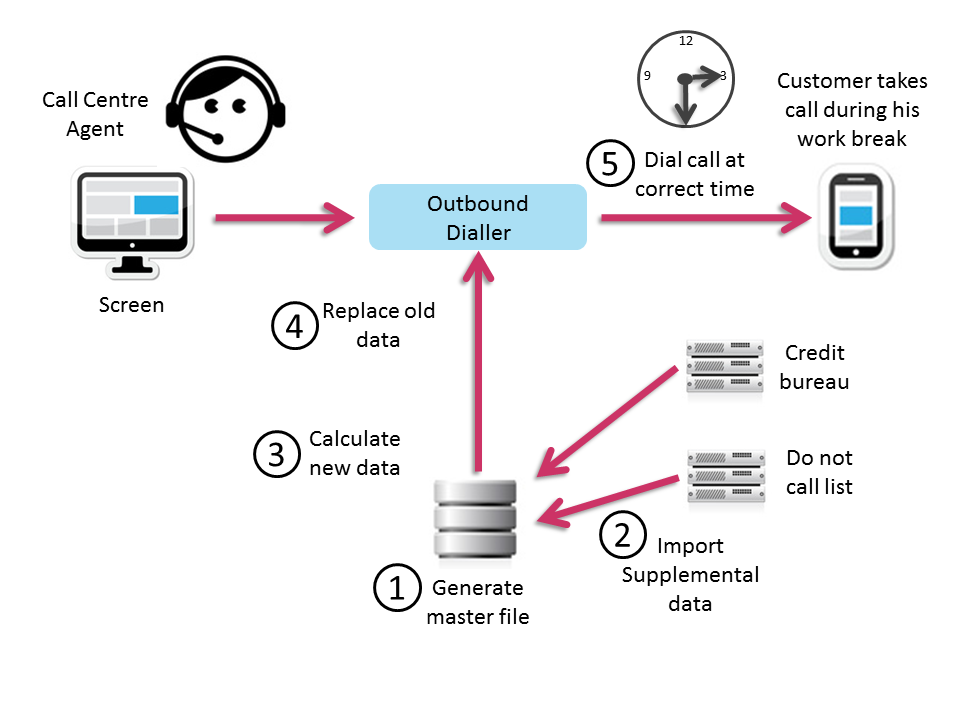A common problem contact centres face is finding the best time to get through to a customer.
With more and more people giving up their landlines and relying solely on their mobile phones and caller ID to screen unwanted calls, the challenge of Right Party Contacts is getting tougher every day.
The solution:
By using a Data Analytics application, such as Noble IQ, organisations can sort call records based upon many factors, such as best time to call, propensity to pay, likelihood to extend a contract.
How it works:

1. The master file
The system administrator generates a master file containing call record data of the target parties that the organisation wishes to contact.
2. Import supplementary data
Supplementary data associated with the information in the master file is imported into the data analytics engine for comparison. Organisations can define this data based upon their specific criteria.
One example could be data based on an individual’s previous contact success rate for outbound calls and the times of previous inbound calls.
By using this information, it’s possible to build a matrix of Best time To Call data that can be used to sort a calling table. It is also possible to go beyond simple Best Time To Call specific times and have multiple entries within a calling table based upon the probability of a call being answered.
For example, there is a 100% chance of a successful contact between 10:00 and 11:00 and an 80% chance between 15:00 and 16:00 but only a 10% chance between 16:00 and 17:00. This may coincide with a shift break at the person’s work.
By taking the probabilities for all contacts throughout a dialling period, it is possible to order records in the most efficient way to minimise the number of unanswered calls.
Some ‘Best Time to Call’ applications try to use call history going back many months or even years. Contact patterns change regularly so a data analytics engine that is capable of rebuilding models on a regular basis will deliver a higher level of Right Party Contacts.
At this stage, simulations can be carried out to validate staffing and calling strategies prior to them being deployed in a production environment.
Some customers, despite lower contact probabilities, are more important than others. In a collections environment this data could be based upon:
- High balance
- High risk
- High probability of payment
- High potential revenue
Some customers are also easier to reach on a specific number or may have a preferred contact channel (voice, email, SMS).
A further example might be the upcoming date of a contract expiration. Analytical data could be based upon loyalty history and contract renewal value. Information relating to previous recent contact history success rates (time periods during which it is more likely to make a right party contact) can also be applied to further optimise the call list.
3. Calculate new data
Based on the outcomes of overlaying the supplementary data over the master file, the data analytics engine can sort the data based upon business rules. For example, scheduled call times can be spread across the day to ensure maximum use of available resources rather than dialling all of the high-value calls first, leaving calls with limited outcome potential remaining at the end of the day.
4. Replace old fields
The old fields from the original master file can now be updated with new fields resulting from the overlay and sorting process. This provides a fully optimised calling list based upon specific parameters defined by business requirements. This optimised file can now be passed to the dialler platform.
Evaluation data can be fed back into the data analytics engine. For example, validation against Do Not Call requests, replacement of duplicate phone numbers, etc.
5. Dial at the correct time
The outbound dialler then makes the outbound call at the time that is most likely to reach the customer.
Some data analytics suites can also provide channel optimisation capabilities enabling them to predict the response from each channel, e.g. the probability of contact or of getting a ‘yes’.
Contacts can also be delivered to the appropriate channel based upon user-defined logic such as:
- Minimum or maximum volumes per channel
- Customer level limits on the number of attempts
The benefits:
- Increased right party contact rates
- Lowered agent idle time with higher connect rates
- Reduced roll rates
- Increased agent productivity
- Increase in revenues
Customers using this solution:
Customers using this type of solution include Go Daddy.com, Afni.com and Select Portfolio Servicing.
This technology toolkit was provided by Alan Trickett, Sales Engineer with Noble Systems.
Author: Megan Jones
Published On: 4th Dec 2013 - Last modified: 21st Jul 2017
Read more about - Technology, Noble Systems, Outbound dialling, Toolkit



































